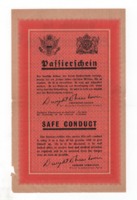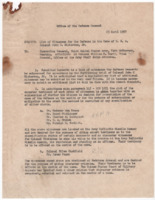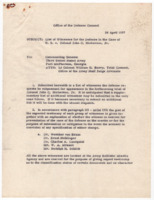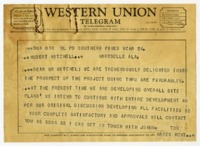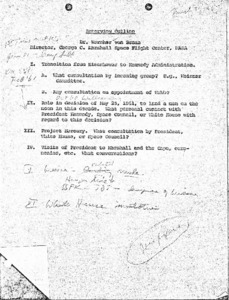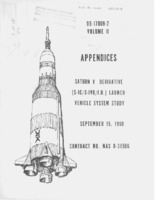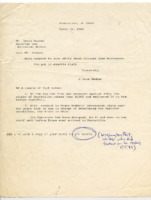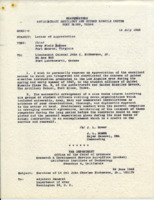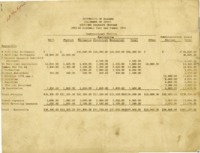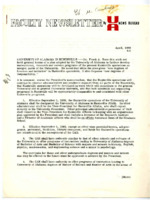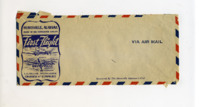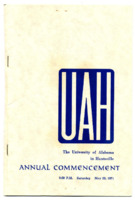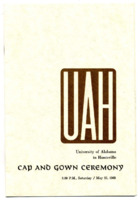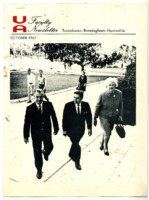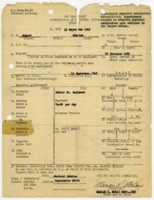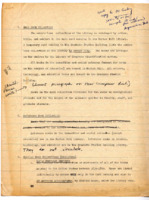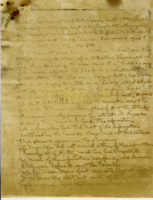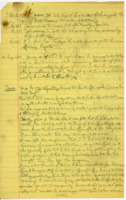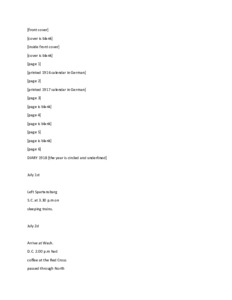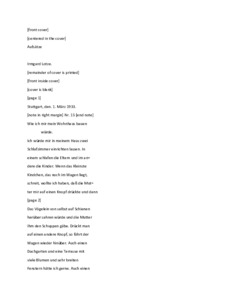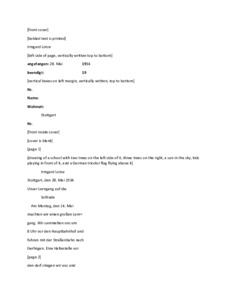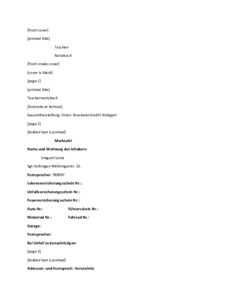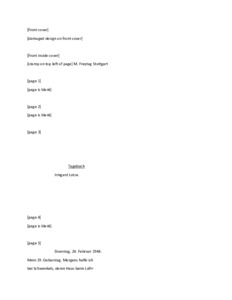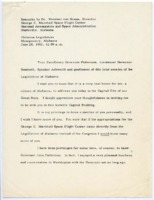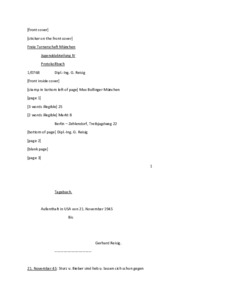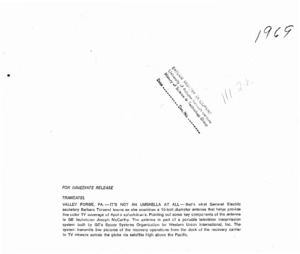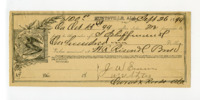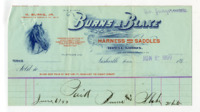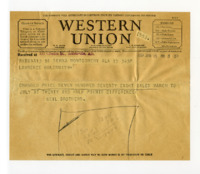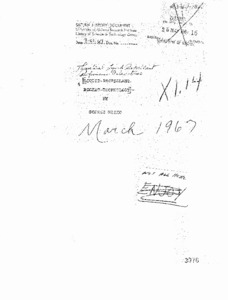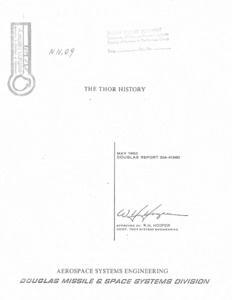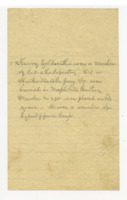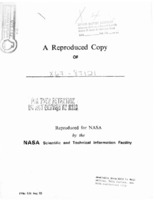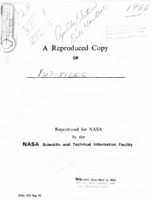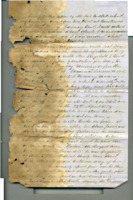
Browse Items (2178 total)
Sort by:
-
Written receipt of payment.
This written receipt acknowledges payment by Hutchens & Murdock for a purchase for the plumbing shop from Huntsville Gas Light Company. -
World War II safe conduct pass.
The pass notes, "The German soldier who carries this safe conduct pass is using it as a sign of his genuine wish to give himself up. He is to be disarmed, to be well looked after, to receive food and medical attention as required, and to be removed from the danger zone as soon as possible." -
World War I diary of Archie Duncan Shannon.
Archie Shannon was a farmer who served in Company G of the 1st Pioneer Infantry in World War I. Shannon was born in Limestone County, Alabama on November 19, 1891, and at the time of his draft registration on June 5, 1917, he lived in Ardmore, Tennessee. Shannon reported for military duty on September 18, 1917 and entered training at Camp Pike, Arkansas.
This diary covers Shannon's experiences in the U.S. Army from July 1, 1918 to July 7, 1919. He describes his journey to France and details everyday life as a soldier, especially the discomforts of life on the front in both the Marne and Verdun sectors. Shannon discusses bathing and sleeping arrangements, gas masks, air raids, and the terrible sights of war-torn France while repairing roads and burying dead soldiers. Shannon includes descriptions of his involvement in the Meuse-Argonne Offensive, noting the continuous shelling, gas attacks, and miserable weather conditions. He also describes his company's reaction to the Armistice, writing, "Many happy hearts in our company everyone seems to take life anew."
Shannon spent the rest of his World War I service in Belgium, Luxembourg, and Germany, and he returned to the United States on July 7, 1919. A list of soldier names and hometowns is recorded in the back of the diary. Shannon died on May 20, 1969 and is buried in Gatlin Cemetery in Ardmore, Alabama. -
Witness list as submitted to the Comannding General, Third United States Army.
In this letter, the Defense Counsel provides a list of witnesses for the defense in the case of John Nickerson. -
Witness list as submitted to the Comannding General, Third United States Army.
In this letter, the Defense Counsel provides a list of witnesses for the defense in the case of John Nickerson. -
Western Union Telegram from Tom Hayes to Hubert Mitchell.
The telegram discusses the park project development and has a note on the back, presumably written by Mitchell, listing what he needs to discuss with Hayes over a telephone call. -
Von Braun, Wernher, Interview Outline.
An outline of an interview with Wernher von Braun. -
Volume II Appendices for the Saturn V Derivative Launch Vehicle System Study.
According to the table of contents, this volume of appendices contain various charts, graphs, and diagrams related to the S-IC stage data, instrument unit data, and vehicle data. -
Various correspondence with David Bowman from 1989 to 1991.
These letters to David Bowman, reporter and editorial writer, all pertain to Bowman's story about Colonel John Nickerson. The first letter includes foot notes and states that he sent a copy of the story to a Washington Post writer. The second letter contains additional information relating to the missile program that may be helpful for the story and a diagram of the original prototype for the Explorer I earth satellite. This set of letters also includes the original letter from David Bowman to Brig. Gen. Harold W. Nelson in which Bowman states he finally photocopied the published transcripts of Colonel Nickerson's court martial. Nelson's reponse follows thanking Bowman for sending the series on Colonel Nickerson. The final letter from Colonel Thomas W. Sweeney includes a working bibliography on the Nickerson case and invites him to visit the Military History Institute. -
Various correspondence regarding Colonel John C. Nickerson, Jr.
This document contains various letters of appreciation received by Colonel Nickerson, efficiency reports, testimonies of Nickerson's character, certificates of achievement, and other services and recommendations pertaining to Nickerson. -
University of Alabama Statement of Costs, Redstone Graduate Program, 1963-1964.
The document outlines costs associated with laboratories and graduate coursework in math, physics, mechanical engineering, and electrical engineering. -
University of Alabama Faculty Newsletter, April 1966.
The newsletter includes the outline of "a plan adopted by the University of Alabama to further develop instructional, research and service programs of the present Huntsville operations as integral parts of the University." The first point of the plan notes, "Effective September 1, 1966, the Huntsville operations of the University of Alabama shall be designated the University of Alabama in Huntsville (UAH)." The plan is signed by Frank A. Rose, president of the University of Alabama. -
Unaddressed air mail envelope.
Pictured is an illustration of an airplane flying over the Tennesee Valley. Sponsored By The Huntsville Salesman's Club. Via Air Mail. L.G. Collier Postmaster Chamber of Commerce -
UAH 1971 "Annual Commencement" program.
The program include the order of events and a list of degree recipients. -
UAH "Cap and Gown Ceremony" program.
Includes a program of events as well as degree recipients. -
UA Faculty Newsletter, October 1967.
The newsletter includes multiple articles describing the growth of the UAH, including cultural events, new faculty appointments, and faculty activities. Also included is a list of events happening on the main University of Alabama campus in November 1967. -
U. S. War Department Notification of Personnel Action.
This document includes details about Schulze's transfer to the United States after World War II, including his health and the terms of his employment as an engineer. -
Typewritten draft of a summary of UAH Library collections.
Includes handwritten notes from Librarian Christel McCanless and others. -
Two handwritten copies of notes of the Nickerson trial.
These handwritten copies contain the testimony of Mr. Weisman. -
Trial notes during United States vs. John C. Nickerson, Jr.
These trial notes include information given by a witness named James during his final testimony. James states that he is the one who suggested the name of journalist Drew Pearson to Colonel Nickerson. -
Transcript of the World War I diary of Archie Duncan Shannon.
Archie Shannon was a farmer who served in Company G of the 1st Pioneer Infantry in World War I. Shannon was born in Limestone County, Alabama on November 19, 1891, and at the time of his draft registration on June 5, 1917, he lived in Ardmore, Tennessee. Shannon reported for military duty on September 18, 1917 and entered training at Camp Pike, Arkansas.
This diary covers Shannon's experiences in the U.S. Army from July 1, 1918 to July 7, 1919. He describes his journey to France and details everyday life as a soldier, especially the discomforts of life on the front in both the Marne and Verdun sectors. Shannon discusses bathing and sleeping arrangements, gas masks, air raids, and the terrible sights of war-torn France while repairing roads and burying dead soldiers. Shannon includes descriptions of his involvement in the Meuse-Argonne Offensive, noting the continuous shelling, gas attacks, and miserable weather conditions. He also describes his company's reaction to the Armistice, writing, "Many happy hearts in our company everyone seems to take life anew."
Shannon spent the rest of his World War I service in Belgium, Luxembourg, and Germany, and he returned to the United States on July 7, 1919. A list of soldier names and hometowns is recorded in the back of the diary. Shannon died on May 20, 1969 and is buried in Gatlin Cemetery in Ardmore, Alabama. -
Transcript of the Civil War diary of George Washington Harris.
Harris served as a private in Company F of the 149th Indiana Infantry Regiment, which occupied Decatur, Alabama in 1865. He enrolled at Terre Haute, Indiana, on February 15, 1865 at the age of twenty. Harris records his experiences as a soldier and traces his journey south to Decatur. Harris was discharged on September 27, 1865. The transcription includes a key to the cipher that Harris sometimes used, as well as notes and clarifications in brackets and parentheses. Also included are the complete lyrics to the Union song "Reply to the Bonnie Blue Flag," part of which Harris records in an entry here. -
Transcript of Irmgard Stuhlinger School Essays, No. 1 to No. 13
Irmgard Stuhlinger was the wife of Ernst Stuhlinger, a scientist acquired in Operation Paperclip. In these school essays, she discusses her daily life in Stuttgart, Germany, as a child. When writing these essays she was 8 years old. Some of the topics include a letter to family members, Christmas, descriptions of the weather, and talking about field trips. -
Transcript of Irmgard Stuhlinger School Essays, from No. 15
Irmgard Stuhlinger was the wife of Ernst Stuhlinger, a scientist acquired in Operation Paperclip. In these school essays, she discusses her daily life in Stuttgart, Germany, as a child. When writing these essays she was 8-9 years old. Some of the topics include letters to family members, a fictional story, Christmas, descriptions of the weather, and talking about field trips. -
Transcript of Irmgard Stuhlinger School Essays, 1934-1935
Irmgard Stuhlinger was the wife of Ernst Stuhlinger, a scientist acquired in Operation Paperclip. In these school essays, she discusses her daily life in Stuttgart, Germany, as a child. When writing these essays she was 9-10 years old. Topics of the essays include family life, a fictional moral story, descriptions of the weather, as well as significant historic events such as the Saarabstimmung (1935 Saar status referendum). Furthermore, she mentions Adolf Hitler (German chancellor) and the Sturmabteilung (Paramilitary organization run by Nazi Germany) in these essays. The transcript includes a description of each illustration. -
Transcript of Irmgard Stuhlinger 1948 Journal
Irmgard Stuhlinger was the wife of Ernst Stuhlinger, a scientist acquired in Operation Paperclip. In this journal she details her daily life starting from January 1st, 1948 to December 31st, 1948. She touches on the topics of post-secondary education, family events, and holidays in the post-war period. At the end of the journal, she includes an entry about the year to come. -
Transcript of Irmgard Stuhlinger 1944-1945 Journal
Irmgard Stuhlinger was the wife of Ernst Stuhlinger, a scientist acquired in Operation Paperclip. In this journal she details her daily life starting from her 19th birthday under the rule of the Third Reich, toward the end of the second World War. She touches on topics such as war, post-secondary education, death of family members, the acquisition of housing, and holidays in the latter part of the war. -
Transcript of a speech given by Wernher von Braun to the Alabama Legislature.
Von Braun, then the director of Marshall Space Flight Center in Huntsville, Alabama, delivered this speech to the legislature in 1961. In the speech, he emphasizes that Alabama must take advantage of its position in the aerospace industry and create a robust "academic and research environment" in Huntsville to attract businesses that "will give birth to major new industries throughout the state." He exhorts the legislature to fund the newly established University of Alabama Research Institute (now part of the University of Alabama in Huntsville), arguing that "the Institute will not only be self-sustaining, but will enrich the State both financially and culturally." The legislature later approved von Braun's request of $3 million for the Research Institute, enabling the purchase of 200 acres of land for the campus and the construction of the Institute in 1964. The speech includes copies of slides von Braun used during his presentation, including diagrams of Saturn and Nova rockets as well as a mockup of a Saturn rocket on the lawn of the state capitol in Montgomery. -
Transcript of 1945-1946 Journal of Gerhard Reisig Dipl.-Ing.
Gerhard Reisig Dipl.-Ing., later Dr. Gerhard Reisig, was a German-American rocket scientist that worked on the team of von Braun at Fort Bliss. This journal covers his journey to the United States under Operation Paperclip, and includes descriptions of his experience to and through his arrival on December 6th, 1946. In this journal, he discusses numerous parts of his travel and experience in the United States including the rail route taken by the group he was in, reviews of two films of the time, comments on fashion and American society, as well as periodic mentions of food culture especially early in the journal. The transcript includes links to copies of the articles he transcribed by hand if they could be found. -
Transatel.
Description of the Transtel without accompanying photograph. -
Transactions between S. Schiffman & Co. and J. W. Erwin and W. V. Styles.
Various documents regarding transactions of different amounts paid by J. W. Erwin and W. V. Styles to S. Schiffman & Co. throughout the year 1899. The final document is a loan form for mules for $409.65. -
Transaction for horses purchased by I. Schiffman.
These documents contain reciepts, correspondence, and payment of the purchase of horse equipment and "1 pair horses" by I. Schiffman. -
Transaction between Weil Brothers and I. Shiffman & Company, Inc.
Correspondence, receipts, and checks from a transaction of cotton between the Weil Brothers and I. Schiffman & Company, Inc. The final three documents detail a re-weight of the 778 bales of cotton two months later, leading to a reduced price by $5,149.13. -
Theoretical liquid propellant performance calculations
Archive copy is a photocopy.; The purpose of these writings is to compile in one volume the basic elements of thermodynamics and gas dynamics which are useful in the evaluation of thrust chamber performance. It is presumed that the reader will have had an elementary course in thermodynamics and gas dynamics. The discussion of topics useful in evaluating thrust chamber performance is, of necessity, limited to these physical effects amenable to other areas that are as yet in the research stage of development. The author would like to take this opportunity to express his gratitude to Mr. G. S. Gill for many stimulating discussions on this subject. Thanks are due to Mr. D. J. Kuyper for permission to utilize his discussion on elastic-plastic strain and its application to nozzle throat area change. Finally, the author wishes to express his gratitude to his wife, Alice, who typed the bulk of the manuscript. -
The History of Thor.
This history is intended as a quick orientation source and as a ready-reference for review of the Thor and its systems. The report briefly states the development of Thor, summarizes and chronicles Thor missile and booster launchings, provides illustrations and descriptions of the vehicle systems, relates their genealogy, explains some of the performance capabilities of the Thor and Thor-based vehicles used, and focuses attention to the exploration of space by Douglas Aircraft Company, Inc. -
The death and burial of Henry Goldsmith.
This handwritten note provides information on the death and burial place of Henry Goldsmith, Oscar's older brother, who was born in 1840. The note reads: "Henry Goldsmith - was a member of Co D - 4 [sic] Infantry - died in Huntsville Ala. Jany 6/17, was buried in Maple Hill Cemetery Marker No. 295 was placed on his grave - He was a member of Egbert J. Jones Camp. -
The "Apollo/Saturn Guide for the Preparations of Specifications: Volume II of II Volumes."
This reproduced copy contains 43 pages of "general instructions for the uniform preparation of Project, System, and Contract End Items Specifications for Apollo/Saturn new equipment and major refurbishment." -
The "Apollo/Saturn Data Handbook."
According to the preface, "This handbook provides KSC management personnel with general information relative to the Apollo-Saturn program. Emphasis is placed on Saturn launch facilities and related support equipment. Saturn vehicle parameters are included for general information. -
Testimony of a Resident of Elizabeth Routt as Requested by Abner Tate.
The author of this written statement is illegible. It appears that the first name of the author may be Francis but it being so faded, is difficult to discern. The author does state that he was living with Elizabeth Route at the time and managing her plantation, during which he became aquainted with Daniel H. Bingham. The written statement, recorded as the author was "called upon by Mr. Tate to state what my testimony was upon his trial...", details the interaction of the author with Bingham, who wished to marry Mrs. Routt, and Mrs. Routt, beginning in March 1854 through 1855.

